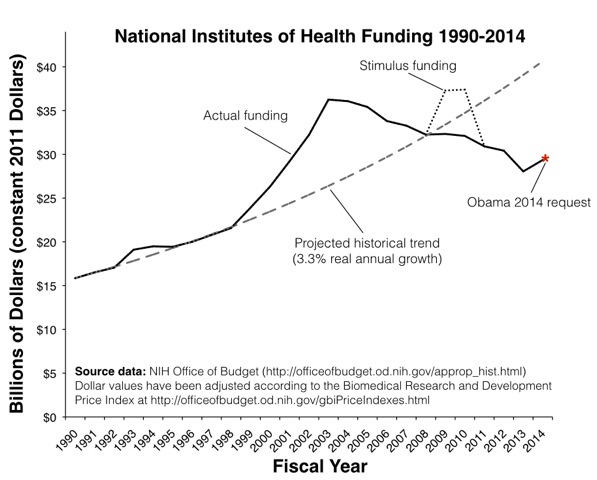I have posted many times here about the devastating impact of the funding reductions at the NIH, particularly how the cuts are destroying the careers of young scientists. The positive impact of the 1998 bipartisan initiative in Congress to double the NIH budget has been completely wiped out and then some.
After all my whinging, I am happy to report that Congress has finally seen the light and given the NIH its first real-term fiscal increase in years. It’s a good start, though much more is needed to sustain the benefit.
I have spent a fair amount of time on Capitol Hill working this issue, and have been struck by the level of bipartisan agreement about the value of NIH spending - it helps both the economy and public health and Members of Congress in both parties see that. I am glad they were able this year to put aside their profound disagreements in other areas and do something good for the country. Here’s hoping they keep it up.

The entire budget deal is pretty baffling. It included other major wins for progressive causes like the multi-year extensions of the solar ITC and wind PTC. If I were a hard conservative, I would have to agree that it represented a cave-in by Speaker Ryan. He could of course blame it on John Boehner, as a poisoned legacy. Next year will be different. Or will it? Another reading is that the tea party caucus are now so unreasonable in their romantic pursuit of death rides that any Republicans with a modicum of interest in governing the country have to seek Democratic votes to pass any legislation at all, giving Nancy Pelosi a surprisingly strong hand.
I'm all for bulking up the NIH budget, but the real crying need is at the NSF. The contrast between $25B-plus for biomedicine alone and $7B-and-change for all of basic science is pretty shocking. My bet is that the marginal NSF dollar has a bigger payoff than the marginal NIH dollar, even in terms of likely long-term progress in wellness and therapy.
There's one institution to which the USA gives a budget of $0: an equivalent to the German Fraunhofer Gesellschaft, which gets €1.7 billion a year for civilian applied technology. That's the income from all sources: 30% core funding from the Federation and Länder. the rest public and private contracts. The Pentagon covers a little of the same ground through ARPA and the DoE through ARPA-E, but it's not systematic. Fraunhofer is a good part of the explanation why Germany still has a thriving civilian manufacturing sector, while those of the UK and the USA are whittled away by Asian competition. It now runs 11 centres outside Germany, of which seven in the USA, a valuable form of imperialism.
The idea that American manufacturing has withered from a lack of competitiveness is a myth. Employment in manufacturing has declined precipitously, but the decline of manufacturing as a percentage of GDP has declined much more gradually, and, in fact, is mirrored by a decline in Germany and the rest of the world. Germany does have a higher percentage of its GDP dedicated to manufacturing, but this isn't a recent development and doesn't really have anything to do with competitiveness. The U.S. has just always had a larger services sector than Germany has.
Now, there are parts of that service sector that are problematic, especially parts of the financial industry, but it's not an issue of competitiveness.
My bet is that the marginal NSF dollar has a bigger payoff than the marginal NIH dollar, even in terms of likely long-term progress in wellness and therapy.
That would be a fun study to try to design; really don't know what the answer would be.
Nothing simpler. I’d run it as a controlled trial.
1. Create a planet identical to the Earth, physically and historically.
2. Add $10 billion to the NIH budget on Earth I, and $10 billion to the NSF budget on Earth II.
3. Wait fifty years.
4. Compare morbidity and mortality.
5. If you don’t like the answer, wait another 50 years.
6. Repeat as necessary.
I doubt repeating the history of Earth would get by the review board.
Indeed. The Stanford/NYU Earth Prison Experiment.
In retrospect, I feel foolish for not seeing how simple this was. Concern: If one planet's residents find out about the study, would they sabotage the other with intergalactic missiles, resistant space viruses etc? And would this truly be a threat to valid inference, if they used their best science to cheat?